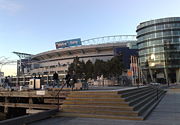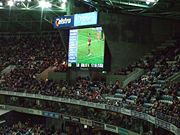Docklands Stadium
Docklands Stadium
Telstra Dome
(The Dome, The Phone Dome) |
|
| Former names |
Colonial Stadium
Victoria Stadium |
| Location |
Melbourne Docklands |
| Broke ground |
1996 |
| Opened |
2000 |
| Owner |
James Fielding Funds Management |
| Operator |
Melbourne Stadiums Limited
Access One |
| Surface |
Grass |
| Construction cost |
AU$250 million |
| Architect |
Daryl Jackson Architects and Hok Sport Architecture |
| Capacity |
53,371 (oval)
56,347 (rectangular) |
| Tenants |
|
|
Docklands Stadium, also known by its sponsored name Telstra Dome, is a multi purpose sports and entertainment stadium in the Docklands precinct of Melbourne, Victoria, Australia.
The stadium was developed as a replacement for Waverley Park. Originally developed by Docklands Stadium Consortium and thereafter controlled by Seven Network the remaining leasehold interest in the stadium on 21 June 2006 was sold to James Fielding Funds Management for AU$330 million.[1] In 2025 the AFL is expected to take over the ownership[2].
Like Waverley, it was built for Australian rules football, unlike most grounds of that size in Australia that were designed for cricket. It is used as a home ground by the AFL clubs Carlton, Essendon, North Melbourne, St Kilda and Western Bulldogs. Other Melbourne-based teams in the AFL competition play home games at the Telstra Dome (along with the MCG). The stadium has also been host to other sporting events, including association football (soccer), cricket, rugby league and rugby union, as well as many general entertainment events such as concerts (Robbie Williams, Barbara Streisand, Bruce Springsteen, Green Day and U2), wrestling (WWE Global Warning, 2002), and boxing (Kostya Tszyu vs Jesse James Leilya, 2003).
The ground hosted two quarter finals of the 2003 Rugby World Cup, the Rugby 7s at the 2006 Commonwealth Games,[3] will be used in the 2008 Rugby League World Cup for the Australia vs England game and will be a part of an Australian bid to host the 2018 FIFA World Cup.[4] In the summer months, it is used as the home ground for Melbourne Victory games in the A-League and the AFC Champions League.
The venue appeared in the 2007 film "Ghost Rider". Its name, wherever visible, has been digitally changed to the SoBe Dome.
Naming rights history

Artist's Impression of the Ethiad Stadium Logo
The stadium was constructed by Baulderstone Hornibrook and opened on 9 March 2000, as Colonial Stadium. Colonial State Bank paid $32.5 million for 10 years of naming rights. [1] In 2000, Commonwealth Bank took over Colonial State Bank and sold the naming rights to Telstra for about $50 million. The name was changed to Telstra Dome on 1 October 2002. It is also colloquially referred to as simply "the Dome", particularly by clubs who are sponsored by rival telecommunications companies. From 1 March 2009 the name will change to Etihad Stadium for 5 years, when the naming rights will transfer to Etihad Airways.[5] After which, the name of the stadium may change yet again. This is in contrast to other sponsored stadiums such as Allianz Arena, where the naming rights won't change for at least 30 years.
Stadium features

Telstra Dome.

Telstra Dome from the docklands side.
- Retractable roof 38 metres (120 ft) above the playing surface, opens east-west, and takes eight minutes to fully open or close.[3]
- Movable seating
- 'Colosseum' arena structure
- Two large internal replay screens which display scores and advertisements.
- External super screen
- 1,000 video seats
- 13 function rooms
- 66 corporate boxes
- Premium Club membership area, The Medallion Club
- 2,500 car parking spaces below the ground
- Oval shaped, turf playing surface of 19,053 square metres (205,080 sq ft) or 170 m × 140 m (560 ft × 460 ft)
- Over 700 2000-watt lights for arena illumination
- A varying capacity of between 12,000 and 74,000, depending on the event. For example seats can be laid on the ground.
- An AFL capacity of 53,371
- The ends of the ground, where the AFL goal posts are located, are named after VFL/AFL goal-kicking legends Tony 'Plugga' Lockett and Gordon Coventry. The northern end is the Lockett End, and the southern end, the Coventry End.
Playing surface issues

A panoramic view of the interior of Telstra Dome with the roof closed. Taken during a Collingwood vs Port Adelaide AFL match. 1 July 2005
Since its inception, Telstra Dome has endured criticism over the quality and suitability of its playing surface, in particular for AFL requirements. It has been criticised by players and coaches for its slipperiness, hardness and lack of grass coverage.[6] The turf has required regular expensive replacement since its inception due to a lack of sunlight inside the stadium. The turf itself is supplied under contract by HG Turf, whereas the responsibility of laying and managing the turf lies with Telstra Dome management.[7]
Issues with the ground's ability to grow grass all year round can be attributed to the stadium's irregular North-South orientation which was a requirement due to its placement between the surrounding roads and Docklands body of water. In particular, the Northern end of the stadium only receives 6 weeks of sunlight a year. Concerts held at the stadium are also usually placed at the Southern end due to the ability for grass to recover faster in that section of the ground.[8]
In August 2007, Telstra Dome chief executive Ian Collins confirmed talks were underway to purchase an elaborate lighting and heating system to allow grass to be grown by curators all year round. This followed extensive visits by Telstra Dome officials to several FIFA World Cup venues in Germany, locations in the United States and Arsenal's new Emirates Stadium.[8]
Studies have also been conducted due to concerns that hard surfaces like Telstra Dome increase the likelihood of player injury, in particular in contributing to anterior cruciate ligament (ACL) injuries (knee).[9]
Attendance records

2006-07 A-League Grand Final at Telstra Dome

One of the Large LCD's at Telstra Dome

A typical
AFL match at the Dome
- Largest attendance
Catholic Jubilee Mass
15 November 2000
70,000 people
- Largest entertainment event attendance
Robbie Williams Close Encounters Tour
18 December 2006
66,500 people
- Largest sporting event attendance
Rugby Union - Australia vs British and Irish Lions
7 August 2001
56,605 people
- Largest A-League attendance
Grand Final, 18 February 2007
Melbourne Victory vs Adelaide United
55,436 people
- Largest AFL attendance
Round 12, 15 June 2007
Carlton vs Hawthorn
53,459 people
- Largest Rugby League attendance
State of Origin Game III, 5 July 2006
Queensland vs New South Wales
54,833 people [10]
- Largest NRL attendance
Preliminary final, 23 September 2007
Melbourne Storm vs Parramatta
33,427 people [11]
External links
References
|
Melbourne landmarks |
|
| Buildings |
|
|
| Precincts |
Chinatown · Melbourne Docklands · Southbank · St Kilda
|
|
| Nature and Parks |
Birrarung Marr · Carlton Gardens · Fitzroy Gardens · Royal Botanic Gardens · Treasury Gardens
|
|
| Cultural Institutions |
Melbourne Aquarium · Melbourne Maritime Museum · Melbourne Museum · Melbourne Zoo · National Gallery of Victoria · National Sports Museum · Scienceworks Museum · State Library of Victoria · Victorian Arts Centre · The University of Melbourne |
|
| Sports |
|
|
| Transportation |
|
|
| Entertainment |
Festival Hall · Entertainment Centre · Crown Casino · Hisense Arena · Luna Park
|
|
| Shopping |
Royal Arcade · Block Arcade · Queen Victoria Market · South Melbourne Market · Prahran Market · Melbourne Central · Chadstone Shopping Centre · Myer Emporium
|
|
|
Australian Football League grounds |
|
| Major grounds: |
|
|
| Minor grounds: |
Aurora Stadium · Carrara Stadium · Manuka Oval · TIO Stadium
|
|
Former AFL/VFL
major grounds: |
Arden Street Oval · Brunswick Street Oval · Coburg Oval · Corio Oval · East Melbourne Cricket Ground · Glenferrie Oval · Junction Oval · Lake Oval · Moorabbin Oval · Princes Park · Punt Road Oval · Victoria Park · WACA Ground · Waverley Park · Whitten Oval · Windy Hill
|
|
| Future grounds: |
Perth Stadium
|
|
|
National Rugby League stadiums and grounds |
|
|
New South Wales
|
ANZ Stadium · Brookvale Oval · Campbelltown Stadium · CUA Stadium · EnergyAustralia Stadium · Jubilee Oval · Leichhardt Oval · Parramatta Stadium · Sydney Football Stadium · Toyota Stadium · WIN Stadium
|
|
|
Queensland
|
Dairy Farmers Stadium · Skilled Park · Suncorp Stadium
|
|
|
Victoria
|
Olympic Park Stadium
|
|
|
ACT
|
Canberra Stadium
|
|
|
New Zealand
|
Mt Smart Stadium
|
|
|
Former Stadiums/Grounds
|
Belmore Sports Ground · Bluetongue Central Coast Stadium · Carrara Stadium · Cazaly's Stadium · Hindmarsh Stadium · Members Equity Stadium · North Sydney Oval · Queensland Sport and Athletics Centre · Seagulls Stadium · Seiffert Oval · Sydney Cricket Ground · Telstra Dome · WACA Ground |
|
|
A-League Stadiums |
|
| Present Stadiums: |
Bluetongue Central Coast Stadium · EnergyAustralia Stadium · Hindmarsh Stadium · Members Equity Stadium · Suncorp Stadium · Sydney Football Stadium · Telstra Dome · Westpac Stadium · Skilled Park · Dairy Farmers Stadium
|
|
| Previous Stadiums: |
North Harbour Stadium · Olympic Park Stadium
|
|
|
International Rules Series |
|
| Tours |
1967 | 1968
|
|
| Series |
1998 | 1999 | 2000 | 2001 | 2002 | 2003 | 2004 | 2005 | 2006 | 2007 (cancelled) | 2008
|
|
| Past Venues |
|
|
| Participants |
Australia | Ireland
|
|





